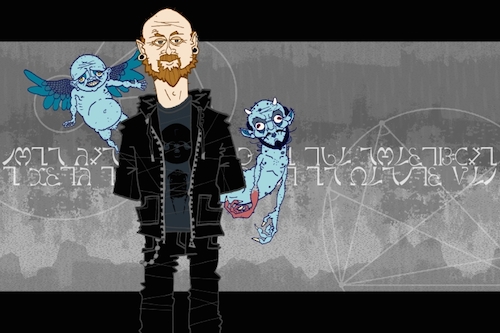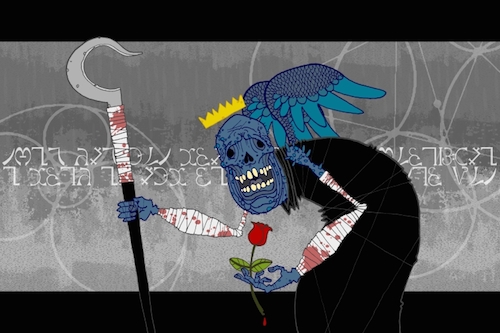Visual Arts Poster Bot — January 27, 2016 13:48 — 0 Comments
A Part Of Living: The Deadly Art Of Ego
In contemporary culture the word “ego” has become synonymous with the word “vanity,” but Freud defined the ego as the functional self, working as a moderator between the internal world of fantasy and the external world of cultural norm. I met a man named Ego, expecting him to be as egotistical as the contemporary fallacy, but was surprised by his refreshingly moderate nature. Although you’d never hear it from him, Ego Shoreclay is a successful painter, tattoo artist and graphic designer, who’s finely detailed explorations in the macabre are sought after by collectors world wide.
I wanted to ask him about his work, but felt a little uncomfortable with his name. “Should I call you Ego, or do you have a less formal name?” I could tell he’d dealt with the issue before. “It’s just Ego,” he said, with the ambivalence of a parent responding to the question, “Are we there yet?” Every bit of research I’d done confirmed the name, but it was so unusual I had to make sure, “I mean, is that your given name or the name you work un-” before I could finish saying “under” he pulled out his ID and showed it to me: first name Ego, last name Shoreclay (organ donor). The gesture effectively ended the inquiry, so I moved on.
Ego is a full time artist. His gallery work has been featured across the country and his tattoo work can be seen on live canvases across the globe. He started as a graphic designer, but his design work is hard to find and I wanted to know why. “I don’t like doing illustration and graphic design,” he said, “because I don’t like dealing with art directors.” No real artist likes being directed. Art is a medium of expression and freedom of expression is the pursuit of any creative individual. Ego shared some horror stories from his design experience, but was happy with what he’d accomplished when given creative license, including poster work for the Punk Rock Flea Market and more famously, the logo for Rat City Rollergirls.
As an illustrator I empathized with Ego’s need to work without restraint, but being familiar with tattoo culture, I also understood how important particulars are when merging art into a living canvas. Getting a cool design isn’t enough. When art becomes a part of you, it only makes sense that you’d have some creative input and I asked Ego how working with a tattoo client differed from having a Creative Director in graphics. “With graphic design I was coming to someone hoping to get work from them,” he said. “In the case of tattoo work, people are coming to me and because I’ve been doing it so long, I can be picky. If someone wants something that’s not what I do, I just let them know. I either turn them away or refer them to someone who would be better suited for what they want… I focus on the projects I enjoy.”
When he confessed that becoming a tattoo artist was the result of peer pressure, I had to learn more. “I had friends who were into tattoos and I’d sometimes design stuff for them,” he said. “I’d go along with them when they got tattooed and became friendly with the tattooers.” With so many people going to other artists for Ego’s designs, eventually friends and even professionals suggested he cut out the middle man. After years of hearing the same thing, he finally got fed up and secretly bought some equipment. His first experiment was on himself, but he worked his way up to tattooing friends and fellow punk-rockers, until finally submitting a portfolio to a studio. “I brought in some photos of the work I’d done and luckily people saw through the crappy pictures of the crappy artwork and recognized that there was some potential.” He currently enjoys working as a staff artist with Fist Full Of Metal, a world class tattoo studio located in Seattle’s up-and-coming Greenwood neighborhood.
Aside from world class artists, Fist Full Of Metal is where Ego also works with a world class lady, his fellow artist and wife, Megon Shoreclay. Since relationships are something I’m always curious about, I asked Ego how his relationship with Megon began. “I never imagined myself getting married,” he said. “We started off just being friends and colleagues and grew closer.”
Shoreclay is a combination of Ego and Megon’s original last names. The pair met while working at Under The Needle (in Belltown) and when a number of Under The Needle artists decided to form their own shop, Megon and Ego joined the Greenwood crew. “Neither of us had pictured the other romantically,” Ego said. “It was one of those things where the friendship just blossomed. I don’t know if it was purely chemical or what, but we were alone together, recognized that weird spark in each other’s eyes and realized that ours was going to be more than a friendship.”
Making art can be a very personal process and artists often need space, so I wondered what it was like for Ego living and working with his spouse. “Historically I’ve always been a person who values his personal time,” he said. “In other relationships I’d make time to be alone and wouldn’t want to be with my romantic partner while producing art. I feel like Megon is a creative equal. She’s a great artist and an especially good tattooer. She also has a personality I enjoy and I like her company outside of anything creative or professional.”
Ego doesn’t spend all his time painting and tattooing. He’s a musician and skateboarder. “Does Megon skate?” I asked, “She does. We share many of the same interests.” I asked what he thought about connections based on commonality. “I can’t speak to the formula for anyone else’s relationship. I can only say that the formula Megon and I found works. We usually see eye-to-eye and in the rare instances when we don’t, it’s easy to resolve our differences. Working with her, living with her, spending our vacation time together… I’m happy to be around her all time.”
Megon isn’t the only artist Ego spends time with. He’s a member of a collective known as the New Mystics and an active member in Seattle’s artistic community, known for his collaborative efforts with local creators. But how is collaborating with someone different from working with an art director? “I guess it’s all in your perception,” he said. “I place a lot of value on friendship and have friends who’s artwork I like. When it comes to collaborating with them, I’m not necessarily relinquishing control, I’m just opening myself up to a different process. It’s interesting and fun to take myself out of my comfort zone by working with people to explore techniques, or styles that I otherwise wouldn’t.”
The best example of Ego’s style is his fine art. After succeeding as a tattoo artist, acrylic and oil finally offered him the opportunity to create without someone dictating what his art should be and the result is like a Saturday-mourning version of the Capuchin catacombs. Influenced by both urban and medieval motifs, his paintings have been described as “objectionable and addictive,” depicting the emaciated kings and queens of nothing, wafting through their barren empires of rock and color.
Aside from cadaverous colors, Ego’s monarchs are often accompanied by esoteric symbols: astrological, alchemical and sometimes alphabetical. He doesn’t add text to every painting, but I’d seen enough of his work to spot a strange language recurring in his backgrounds and wondered what secret messages he was trying to communicate. “I try to keep my secrets secret,” he said smiling, “but I’m happy to give hints and can tell you that the name of the code is Enochian…”
Enochian is the language of angels and whether or not he’s seen in all of Ego’s work, The Angel Of Death seems to be perpetually close at hand. Death is the single most recurring theme in Ego’s portraits and though his reviewers always focus on Ego’s dark-side, I saw more life in his imagery. “I’m not trying to make things that are especially terrifying,” he said. “They’re creepy for sure, but they don’t look like they’re trying to murder you. They have a weird innocence to them.” I pointed out that most of his so-called creatures had an almost childlike quality. “I put a lot of value on youth,” he said, “not the physical state of being young, but the mental state of youthfulness and I try to make things somehow youthful. I think maybe the reason for that is that I myself feel like a stunted child.”
In American society everything is done to avoid talking about death and Ego’s work stands out because death’s theme is featured so prominently. Granted, he paints a pretty picture of it, but pretty or not he still chooses to paint death and I wanted to understand why. “People think that by not talking about it, they’re avoiding their mortality,” he said, “but we live and we die. It’s as natural as any other part of human life.”
“Do you paint death as a reminder to live?” I asked, “A reminder to live yes, but also a reminder that you are going to die. I don’t think death should be a terrifying thing.”
Ego came to grips with his own mortality at an early age and doing so has helped him in more ways than one. More than an artist, Ego is a man and in a society full of fears, Ego is a man who’s let go of society’s worst fear in order to focus on living. For most of us, life may end in death, but for Ego death is just a part of living. He never knew he wanted to be a tattoo artist or even a husband, but by accepting death and embracing life, life comes to him.
The answer isn't poetry, but rather language
- Richard Kenney





